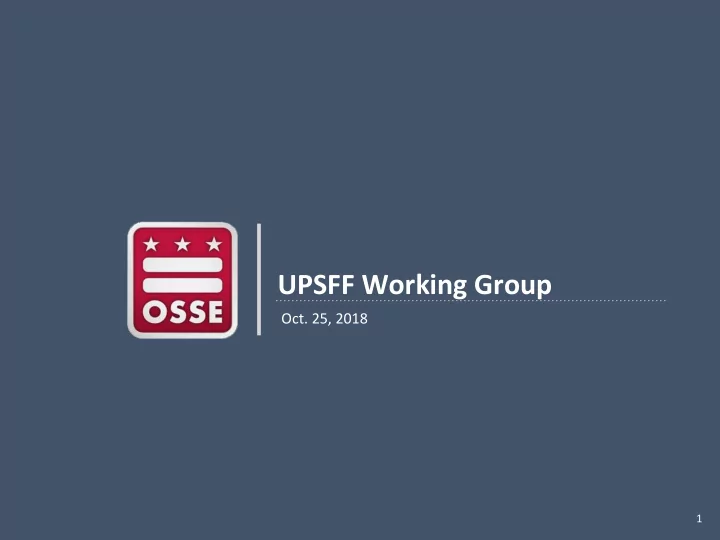

UPSFF Working Group Oct. 25, 2018 1
Agenda • Welcome and Introductions (5 min) • Timeline Overview (5 min) • National Landscape Review (25 min) • Focus Areas: At Risk, English Learners, Special Education (35 min) • Adequacy Study Specifications • At Risk Characteristics and Overlap • School Outcomes: Bold Performance Schools • Driving Questions and Discussion • Public Comment Period (15 min) • Up Next (11/29) (5 min) 2
Timeline Overview AUG SEPT OCT NOV DEC Introductory Meeting Monthly Group Meeting Monthly Group Meeting Monthly Group Meeting Review Draft Report UPSFF Review Process, UPSFF Adequacy Study Review, Focus National Landscape Review Focus Area Discussion and Finalize Focus Area Discussion Overview, and Focus Area Area Selection Follow Ups from Adequacy Deep Dive Review and Comment on Draft Introduction Study Review Preliminary Recommendations Report Focus Area Overview and Deep Dive on At Risk 3
Timeline Overview: Working Group Goals • Responsibilities of UPSFF working group : • Provide input and develop recommendations regarding revisions to the UPSFF • Goals for the working group: • Examine the UPSFF and district-wide budgeting in practice (August) • Revisit Adequacy Study of education costs in the District (September) • Review national landscape, including research in education and education finance (October) • Develop recommendations regarding revisions to the UPSFF on the focus area categories: At Risk, ELL, and SPED (October, November and December) • Recommend areas of further study following the report’s publication (October, November and December) 4
National Landscape Review • During the September meeting, working group members asked how other jurisdictions handle funding for at risk, English Learner, and special education students, and how does Washington, DC compare. • See accompanying presentation by Katie Hagan of the Edunomics Lab at Georgetown University. 5
Adequacy Study Resource Specifications • In response to a question raised at the September meeting, what resources did the Adequacy Study include in their specifications for at risk, English language learner, and special education students? • After the Edunomics Lab presentation, how should we approach the Adequacy Study’s resources and specifications? 6
Adequacy Study Resource Specifications for Special Populations: Staff • Additional staff to support special needs students: at-risk students, English language learners, and special education students • At-risk students : additional teachers to lower class sizes for at-risk students in secondary schools; additional pupil support positions, such as counselors, nurses, psychologists, social workers, and family liaisons (roughly 100:1); interventionists (100:1); and district-level services • English language learners : ELL teachers (15:1 for Levels 1 and 2, 22:1 for Level 3); pupil support positions (100:1); bilingual aides (50:1); bilingual service provider (ELL coordinator) positions; and district-level services • Special education students : Special education teachers (ranging from 22:1 to 8:1 by level of need); instructional aides for higher need levels; additional pupil support (psychologists and social workers) and therapist support (speech, occupational, and physical therapy); school-level special education coordinators; and district-level services 7
Adequacy Study Resource Specifications for Special Populations: Programs • Before- and after-school programs for at-risk students and ELL students (100% of at risk and Level 1 and Level 2 ELL students) • Summer school for at-risk and ELL students (100% of at-risk students and all Level 1 and Level 2 ELL students); and summer bridge programs for students entering 9th grade 8
At Risk Characteristics • In response to a question raised at the September meeting, are there overlaps in the characteristics of at risk students found when looking more in depth at the definition? 9
At Risk Sub-Categories: Overlap • FY18 characteristics of students at risk of academic failure: • 1% are students in foster care • 14% are students who are homeless • 44% are students who live in low-income families eligible for Temporary Assistance for Needy Families (TANF) • 86% are students who qualify for the Supplemental Nutrition Assistance Program (SNAP) • 11% are high school students that are one year older, or more, than the expected age for the grade in which the student is enrolled • Overlap of characteristics • Students can be in more than one category simultaneously; only one category is necessary to be considered at risk of academic failure 10
At Risk Sub-Categories: Overlap TANF SNAP CFSA Homeless Overage TANF 47% 18% 47% 19% SNAP 92% 25% 67% 43% CFSA 0.4% 0.3% 1% 1% Homeless 15% 11% 11% 43% Overage 5% 5% 11% 34% Examples: 47% of SNAP eligible are TANF eligible. 92% of TANF eligible are SNAP eligible. Note: Based on 17-18 enrollment audit data
School Outcomes: Bold Performance Schools • In response to a question raised at the September meeting, which schools with high at risk student populations perform at higher levels when compared with similar schools? 12
School Outcomes: Bold Performance Schools • 13
School Outcomes: Bold Performance Schools 14
At Risk Discussion: Driving Questions • National perspective • What was interesting/compelling from the national landscape review? • When looking to the report, are there areas we need to further study to provide our recommendations? • At Risk Concentration and Definition • Should at risk concentrations be considered in the UPSFF (school-level, student-level, both)? • How do we know if our at risk definition captures the right students? • At Risk and Outcomes • How can the Bold Performance analysis inform the working group’s recommendation on at risk? • What information is necessary to better understand school outcomes? 15
Public Comment • Time for non-members to provide feedback or comments 16
Up Next • Next Meeting: November 29, 3:30-5:00 • Draft Agenda: • Focus area topics • Develop preliminary recommendations 17
Recommend
More recommend